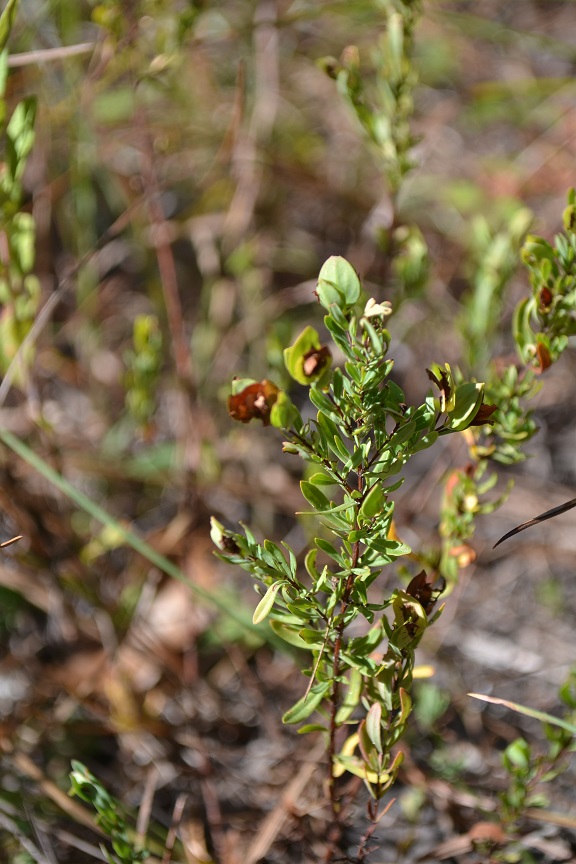Difference between revisions of "Hypericum hypericoides"
(→References and notes) |
(→Photo Gallery) |
||
| Line 49: | Line 49: | ||
==Cultivation and restoration== | ==Cultivation and restoration== | ||
==Photo Gallery== | ==Photo Gallery== | ||
| + | <gallery widths=180px> | ||
| + | </gallery> | ||
| + | |||
==References and notes== | ==References and notes== | ||
Florida State University Robert K. Godfrey Herbarium database. URL: [http://herbarium.bio.fsu.edu http://herbarium.bio.fsu.edu]. Last accessed: June 2014. Collectors: Ann F. Johnson, Wilson Baker, Loran C. Anderson, Leon Neel, R. Komarek, R.A. Norris, R.F. Doren, Robert K. Godfrey, Andre F. Clewell, Kevin Oakes, Chris Cooksey, and Sidney McDaniel. States and Counties: Florida: Franklin, Jackson, Jefferson, Lee, Leon, and Wakulla. Georgia: Baker and Thomas. Texas: Orange. Other Countries: Dominican Republic. | Florida State University Robert K. Godfrey Herbarium database. URL: [http://herbarium.bio.fsu.edu http://herbarium.bio.fsu.edu]. Last accessed: June 2014. Collectors: Ann F. Johnson, Wilson Baker, Loran C. Anderson, Leon Neel, R. Komarek, R.A. Norris, R.F. Doren, Robert K. Godfrey, Andre F. Clewell, Kevin Oakes, Chris Cooksey, and Sidney McDaniel. States and Counties: Florida: Franklin, Jackson, Jefferson, Lee, Leon, and Wakulla. Georgia: Baker and Thomas. Texas: Orange. Other Countries: Dominican Republic. | ||
Radford, Albert E., Harry E. Ahles, and C. Ritchie Bell. Manual of the Vascular Flora of the Carolinas. 1964, 1968. The University of North Carolina Press. 709-713. Print. | Radford, Albert E., Harry E. Ahles, and C. Ritchie Bell. Manual of the Vascular Flora of the Carolinas. 1964, 1968. The University of North Carolina Press. 709-713. Print. | ||
Revision as of 19:54, 16 February 2016
| Hypericum hypericoides | |
|---|---|

| |
| Photo taken by Kevin Robertson | |
| Scientific classification | |
| Kingdom: | Plantae |
| Division: | Magnoliophyta - Flowering plants |
| Class: | Magnoliopsida – Dicotyledons |
| Order: | Theales |
| Family: | Clusiaceae ⁄ Guttiferae |
| Genus: | Hypericum |
| Species: | H. hypericoides |
| Binomial name | |
| Hypericum hypericoides (L.) Crantz | |

| |
| Natural range of Hypericum hypericoides from USDA NRCS Plants Database. | |
Common name: St. Andrew's cross
Contents
Taxonomic notes
Description
Hypericum hypericoides is a perennial shrub species.
“Usually glabrous herbs or shrubs. Leaves usually punctate, simple, opposite, entire, usually sessile or subsessile, exstipulate. Inflorescence basically cymose; flowers perfect, regular, bracteates, subsessile or short-pedicellate, sepals 2, 4, or 5, persistent; petals 4 or 5, usually marcescent, yellow or pink; stamens 5-numerous, separate or connate basally forming 3-5 clusters or fascicles, filaments usually persistent; carpels 2-5, stigmas and styles separate or fused, ovary superior, 1-locular or partly or wholly 2-5 locular, placentation axile or parietal. Capsules basically ovoid, longitudinally dehiscent, styles usually persistent; seeds numerous, lustrous, areolate, cylindric or oblong. In general our species form a polymorphic complex with many intergrading taxa.” – Radford et al 1964
"Shrub 3-10 dm tall with erect or ascending, wing-angled. Leaves elliptic, linear, or oblanceolate, 8-26 mm long, 1-7 mm wide, acute or obtuse, base cuneate, notched. Flowers solitary, axillary, or ins mall cymules; bracts paired, at base of sepals; pedicels ascending, 1-5 mm long. Outer sepals 2, ovate, or widely elliptic, 5-12 mm long, 3.5-7 mm wide, acute, base frequently subcordate, inner sepals usually obsolete; petal 4, 6-10 mm long; styles 2, partly fuse, 0.5-1 mm long, ovary 1-locular. Capsules ovoid, 4-9 mm long, 2.5-4 mm long, 2.5-4 mm broad; seeds black, ca.1 mm long." - Radford et al 1964
Distribution
Ecology
Habitat
H. hypericoides occurs in wet or moist loamy soils and semi-shady to open light conditions (FSU Herbarium). It can be found in annually burned longleaf pineland, wetland depressions, limestone glades, and by ponds (FSU Herbarium). However, it also appears in disturbed areas including roadsides, open fields, and pine plantations (FSU Herbarium). It has been associated with areas that are heavily logged, herbicided for woody plants, and burned several times, as compared to unlogged areas that are selectively herbicided for hardwoods and infrequently burned.[1] Associated species include Pinus palutris and Pinus elliottii (FSU Herbarium).
Phenology
Flowering has been observed in March and September, while fruiting has been observed in September (FSU Herbarium).
Seed dispersal
Seed bank and germination
Fire ecology
This species has been found in habitat that is burned annually, indicating some level of fire tolerance (FSU Herbarium).
Pollination
Use by animals
Diseases and parasites
Conservation and Management
Cultivation and restoration
Photo Gallery
References and notes
Florida State University Robert K. Godfrey Herbarium database. URL: http://herbarium.bio.fsu.edu. Last accessed: June 2014. Collectors: Ann F. Johnson, Wilson Baker, Loran C. Anderson, Leon Neel, R. Komarek, R.A. Norris, R.F. Doren, Robert K. Godfrey, Andre F. Clewell, Kevin Oakes, Chris Cooksey, and Sidney McDaniel. States and Counties: Florida: Franklin, Jackson, Jefferson, Lee, Leon, and Wakulla. Georgia: Baker and Thomas. Texas: Orange. Other Countries: Dominican Republic.
Radford, Albert E., Harry E. Ahles, and C. Ritchie Bell. Manual of the Vascular Flora of the Carolinas. 1964, 1968. The University of North Carolina Press. 709-713. Print.
- ↑ Cipollini, M. L., J. Culberson, et al. (2012). "Herbaceous plants and grasses in a mountain longleaf pine forest undergoing restoration: a survey and comparative study." Southeastern Naturalist 11: 637-668.